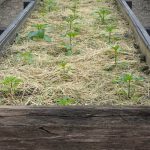Are you interested in learning how to do vegetable gardening at home? This article will guide you through the process of growing your own delicious and nutritious veggies right in your own backyard. From selecting the right location for your garden to harvesting and preserving your homegrown produce, we will cover all the essential steps to help you become a successful home gardener.
Before you get started on creating your vegetable garden, it’s important to choose the right location for optimal plant growth. We will discuss the factors to consider when selecting the best spot for your garden and provide helpful tips to ensure a thriving vegetable patch.
Once you have chosen the perfect location, it’s time to select the vegetables that are best suited for home gardening. We will provide guidance on choosing a variety of vegetables that are well-suited for beginner gardeners and offer advice on how to care for each type of plant.
Stay tuned as we dive into soil preparation, planting techniques, pest management, and harvesting tips. Whether you’re a seasoned gardener or just starting out, this comprehensive guide will equip you with everything you need to know about growing fresh and healthy vegetables at home.
Choosing the Right Location for Your Vegetable Garden
When it comes to starting a vegetable garden at home, one of the most crucial factors to consider is the location. The success of your garden largely depends on where you choose to plant it. The ideal location for a vegetable garden should receive at least 6-8 hours of sunlight per day and have well-drained soil. Without adequate sunlight, your plants may struggle to grow, which can result in poor yields.
Another important consideration when choosing the right location for your vegetable garden is proximity to a water source. Vegetables need regular watering, especially during dry spells, so it’s essential to have easy access to water when needed. Additionally, try to select a spot that is shielded from strong winds, as this can damage delicate plants and disrupt their growth.
If you’re working with limited space, consider vertical gardening or using containers that can be moved around to follow the sun throughout the day. This allows you to maximize space and ensure that your vegetables are getting the sunlight they need.
In summary, choosing the right location for your vegetable garden sets the foundation for a successful harvest. By considering factors such as sunlight, soil drainage, water access, and protection from harsh elements, you can create an optimal environment for your homegrown veggies to thrive.
| Factors | Considerations |
|---|---|
| Sunlight | 6-8 hours per day |
| Soil Drainage | Well-drained soil |
| Water Access | Proximity to a water source |
Selecting the Best Vegetables to Grow at Home
When it comes to starting a vegetable garden at home, choosing the right vegetables to grow is essential for a successful harvest. Whether you have limited space or a large backyard, there are plenty of vegetables that can thrive in a home garden. Here are some popular choices for beginners:
Tomatoes
Tomatoes are one of the most popular vegetables to grow at home. They can be grown in containers or directly in the ground, and they require plenty of sunlight. There are many varieties to choose from, including cherry tomatoes, heirloom tomatoes, and beefsteak tomatoes.
Lettuce
Lettuce is an easy and quick-growing vegetable that is perfect for beginners. It can be grown in small spaces and even in containers. With different types like leaf lettuce, romaine lettuce, and butterhead lettuce, you can enjoy a variety of salads throughout the growing season.
Peppers
Peppers come in a variety of colors, shapes, and flavors, making them a great addition to any home garden. Whether you prefer sweet bell peppers or spicy chili peppers, they are relatively low-maintenance and only require consistent watering and sunlight.
When selecting the best vegetables to grow at home, consider your climate, available space, and personal preferences. Remember to research each vegetable’s specific requirements for soil type, sunlight exposure, and water needs before planting them in your home garden.
Preparing the Soil for Planting
One of the most important steps in successful vegetable gardening at home is preparing the soil for planting. The quality of your soil will directly affect the health and productivity of your vegetable garden. Here’s how to ensure that your soil is ready for planting:
First, it’s essential to test the pH level of your soil. Most vegetables thrive in soil with a pH level between 6 and 7. You can purchase a pH testing kit at your local garden center or use a soil testing service to determine the current pH level of your soil.
Next, you’ll want to enrich your soil with organic matter such as compost or well-rotted manure. This will improve the structure and fertility of the soil, providing essential nutrients for your growing vegetables. Work the organic matter into the top several inches of soil using a garden fork or tiller.
Finally, consider adding additional nutrients to the soil based on the specific needs of the vegetables you plan to grow. For example, some plants may benefit from extra nitrogen, phosphorus, or potassium. A comprehensive fertilizer specifically formulated for vegetable gardens can help provide these essential nutrients.
By taking these steps to prepare your soil before planting, you’ll give your homegrown vegetables the best possible start and set yourself up for a successful growing season.
| Steps | Description |
|---|---|
| Test Soil pH | Determine pH level using a testing kit or service |
| Enrich with Organic Matter | Improve fertility by adding compost or manure |
| Add Nutrients | Consider additional nutrients based on plant needs |
Planting and Caring for Your Vegetable Garden
Once you have chosen the right location for your home vegetable garden and selected the best vegetables to grow, it’s time to start planting and caring for your plants. Below are some essential tips on how to do vegetable gardening at home to ensure a successful and bountiful harvest:
1. Start with seedlings or seeds: Depending on the type of vegetables you want to grow, you can either start with seedlings or plant seeds directly into the soil. Some vegetables, such as tomatoes and peppers, are usually started from seedlings, while others like carrots and lettuce can be grown from seeds.
2. Planting depth and spacing: It’s crucial to follow the recommended planting depth and spacing for each type of vegetable to ensure healthy growth. Overcrowding can lead to stunted growth and increased susceptibility to pests and diseases. Use a trowel or gardening fork to dig holes for your seedlings or seeds according to the specific requirements for each vegetable.
3. Watering and fertilizing: Proper watering is essential for the health of your vegetable garden. Most vegetables require regular watering, especially during hot weather. It’s important to water the soil around the base of the plants rather than overhead, which can lead to moisture-related diseases. Additionally, providing a balanced fertilizer can help promote healthy growth and improve overall crop yield.
Caring for your vegetable garden also involves regular maintenance tasks such as weeding, mulching, and monitoring for signs of pests or diseases. By following these tips on how to do vegetable gardening at home, you can enjoy a thriving garden that provides an abundance of fresh produce throughout the growing season”.
Dealing With Common Pests and Diseases
Identifying Common Pests and Diseases
One of the challenges of home vegetable gardening is dealing with common pests and diseases that can affect your plants. Some of the most common pests include aphids, slugs, and caterpillars, while diseases such as powdery mildew and tomato blight can also impact the health of your vegetables. It’s important to be able to identify these pests and diseases early on so that you can take appropriate action to prevent them from spreading.
Natural Pest Control Methods
Instead of resorting to chemical pesticides, consider using natural pest control methods to protect your vegetable garden. For example, companion planting involves growing certain plants together to deter pests, while beneficial insects like ladybugs and lacewings can help keep pest populations in check. Additionally, you can make homemade organic sprays using ingredients like garlic, neem oil, or soap to repel pests without harming the environment or beneficial insects.
Preventing Diseases in Your Vegetable Garden
To prevent diseases from taking hold in your vegetable garden, it’s important to practice good gardening hygiene. This includes rotating your crops each season to prevent soil-borne diseases from building up, as well as providing adequate spacing between plants for good air circulation. Using disease-resistant varieties of vegetables can also help minimize the risk of infections. Finally, be mindful of watering practices – overhead watering should be avoided as it can promote the spread of fungal diseases.
By being proactive in identifying and addressing common pests and diseases in your home vegetable garden, you can ensure a healthy and bountiful harvest for you and your family.
Harvesting and Preserving Your Homegrown Vegetables
Once your vegetables are ready for harvest, it’s time to reap the rewards of your hard work. Harvesting vegetables at the right time is crucial for their taste and freshness. Some vegetables, like tomatoes and peppers, should be picked when they are fully ripe, while others, such as lettuce and spinach, can be harvested as soon as they reach a desirable size. It’s important to research each vegetable variety to know when it’s best to harvest.
Preserving your homegrown vegetables allows you to enjoy them long after the growing season has ended. There are several methods for preserving vegetables including canning, freezing, pickling, and drying. Canning is a great way to store tomatoes, beans, and other low-acid vegetables, while freezing works well for many types of produce such as peas and corn. Pickling is popular for cucumbers and other firm vegetables, and drying is ideal for herbs and hot peppers.
Proper storage of freshly harvested vegetables is essential to maintain their flavor and nutritional value. For example, root vegetables like carrots and beets can be stored in a cool, dark place with high humidity to prevent them from drying out.
On the other hand, leafy greens like kale and lettuce should be stored in the refrigerator wrapped in damp paper towels to keep them crisp. By taking the time to properly harvest and preserve your homegrown vegetables, you can enjoy their delicious flavors throughout the year.
Tips for Successful and Sustainable Vegetable Gardening at Home
When it comes to successful and sustainable vegetable gardening at home, there are a few key tips to keep in mind. One of the most important factors for a thriving garden is choosing the right location. Make sure your chosen spot receives ample sunlight, has good drainage, and is easily accessible for regular maintenance. You’ll also want to consider the proximity to a water source, as consistent watering is crucial for healthy plant growth.
In addition to selecting the right location, it’s essential to choose the best vegetables to grow at home based on your region’s climate and growing season. Research which vegetables are well-suited for your area and make sure to select a variety that you and your family enjoy eating. This will not only ensure a successful harvest but also add value and satisfaction as you cultivate your garden.
Preparing the soil for planting is another critical step in successful vegetable gardening at home. Prior to planting, test the soil’s pH level and amend it accordingly with compost or organic matter if necessary. This will provide essential nutrients for your plants throughout their growing season. Proper soil preparation sets the foundation for healthy root development and overall plant growth.
In order to minimize pests and diseases in your home vegetable garden, practice regular monitoring and maintenance. Consider using natural pest control methods such as companion planting, mulching, or introducing beneficial insects. By staying proactive in caring for your garden, you can mitigate potential issues before they become problematic and ultimately achieve a more sustainable gardening practice overall.
Conclusion
In conclusion, learning how to do vegetable gardening at home can be a rewarding and fulfilling experience. From choosing the right location and selecting the best vegetables to preparing the soil, planting, and caring for your garden, there is a sense of pride and satisfaction in nurturing your own produce. Dealing with common pests and diseases can be daunting, but with proper knowledge and care, you can successfully overcome these challenges.
Harvesting your homegrown vegetables is a truly gratifying experience. Knowing that you have grown these nutritious and delicious vegetables yourself adds an extra level of enjoyment to every meal. Additionally, preserving your surplus produce through freezing, canning, or pickling allows you to enjoy the fruits (and veggies) of your labor long after the growing season has ended.
In summary, sustainable vegetable gardening at home involves dedication, patience, and hard work. However, the benefits are well worth it. Not only will you have access to fresh and healthy produce right in your own backyard, but you will also gain valuable skills in self-sufficiency and sustainability. So roll up your sleeves, get your hands dirty, and start enjoying the many rewards of growing your own vegetables at home.
Frequently Asked Questions
How Do I Start a Vegetable Garden at Home?
Starting a vegetable garden at home can be an exciting and rewarding experience. Begin by choosing a suitable location with plenty of sunlight and access to water. Prepare the soil by removing any weeds and adding organic matter. Consider starting with easy-to-grow vegetables like tomatoes, lettuce, and green beans.
What Vegetables Can Beginners Grow in a Garden?
For beginners, it’s best to start with vegetables that are relatively low-maintenance and quick to grow. Some good options include tomatoes, zucchini, radishes, and salad greens like lettuce and spinach. These vegetables are generally easy to care for and can provide a satisfying harvest for novice gardeners.
What Are the Basics of Vegetable Gardening?
The basics of vegetable gardening involve understanding the needs of different plants in terms of sunlight, water, soil quality, and spacing. It’s important to prepare the soil properly by loosening it and adding compost or other organic matter. Regular watering is essential, especially during dry periods.
Additionally, staying on top of weeding and pest control will help ensure a successful harvest. Finally, it’s crucial to know when to harvest your vegetables for the best flavor and quality.

If you’re looking to get into vegetable gardening, or are just looking for some tips on how to make your current garden better, then you’ve come to the right place! My name is Ethel and I have been gardening for years. In this blog, I’m going to share with you some of my best tips on how to create a successful vegetable garden.





